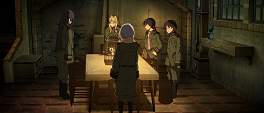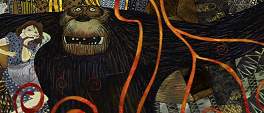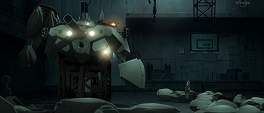The easiest way to describe Sora no Woto is to identify its most obvious influences. Already well established is the K-On! style gelatinous character designs however the set up and pacing has more in common with Haibane and its European influenced locale. Most prominent however is the tonal similarities to the Valkyria Chronicles series which is unsurprising given Studio A1 Pictures' leading role in its production, likewise for the animation which shares a great deal with Kannagi. The entire package is distinctly different to all of its progenitors but the opening episodes can't fully escape the gravity of its derivations.
Kanata, who in her infancy witnessed a beautiful woman playing a trumpet to the sky, joined the army in the hope of learning to play her bugle for free. Upon arriving in the town of Seize she is caught up in a local festival and, after dirtying her military uniform, is taken in by the curt Rio. Kanata inadvertently loses Rio's pendant and forgoes her induction into the local barracks to search for it only to be lost herself and needs to be rescued by those she was due to meet earlier. What follows is an introduction to the slow life of an isolated border-town's army base and the numerous inconsequential adventures that result from it.
The opening minutes of Sora no Woto succinctly pose the most puzzling aspect of the series: what are flimsy children doing in the army? Kanata wakes up on a train with several burly gentlemen playing cards nearby who proceed to have tea served to them by the ditsy adolescent; putting aside the gender issue, the army must either be woefully understaffed or the recruiting officer entirely too lax to allow such an obviously unprepared group of recruits to congregate. Exploring the fallibility of the plot however is pointless when the only reason for their most privileged situation is to gently meander around their personalities and interactions. In only three episodes there are frightful journeys into an abandoned school where a ghost supposedly lurks and the sudden fever of one the troupe which dredges up painful memories for Rio. Of course there are hints at deeper intrigue such as the history of the Fire Maidens, given flesh through the opening, and the legless multipedal tank sitting in their hangar, but the focus is almost wholly on their daily tribulations and burgeoning relationships.
In and of itself this approach is not a problem, however the series' derivative nature hampers enjoyment by ensuring every character is a facsimile or amalgamation of existing archetypes. Kanata has a foppish, exaggerated innocence to her, Rio throws herself head long into the big sister role, Felicia plays the softly-spoken matriarch, Noel - despite her awesome name - is quickly branded as the personality-deficient silent type, and lastly Kureha who is depressingly obnoxious and insecure. The entire group could have been lifted whole or piecemeal from any number of other similarly positioned shows, and once the aesthetic similarities are taken into account, the conclusion can only be that this is a cynically constructed series targeted for maximum marketability and minimum friction.
In short, Sora no Woto attempts to ride on the success of other series but fails to contribute anything to the formula. The first three episode present a story absurd enough to be mildly interesting and a cast familiar enough to be vaguely obnoxious; its saving graces are the superbly produced backgrounds which breath tangibility into every scene and the rich opening by Yuki Kajiura's Kalafina, a group who will no doubt go on to do further similar works after Kara no Kyoukai's success. Easy to digest but sits uncomfortably in the stomach, this is with any luck the last of its kind and although later episodes may gift the characters with worthy development, in all likelihood it will stagnate and maunder. As it is, Sora no Woto hovers just over the dividing line of entertainment and tepid mediocrity.







